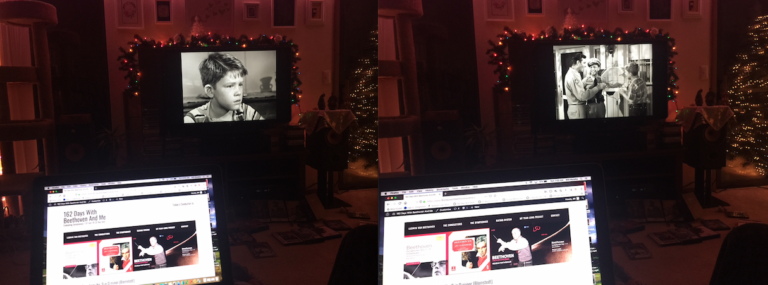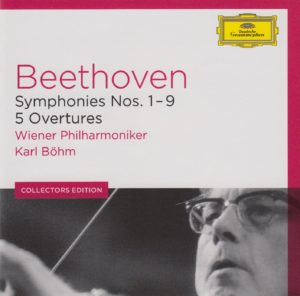
My listening post this morning is with one of the most famous episodes of The Andy Griffith Show in the background: “Opie the Birdman” (Season Four, Episode One).
If you ever get a chance to watch “Opie the Birdman,” do it. The last line of dialogue is one of the most famous – and poignant – in the history of television.
Anyway, while Opie learns a lesson, I’m listening to Austrian conductor Karl Bohm (1894-1981), Wiener Philharmoniker, and Beethoven’s Symphony No. 9 in D minor.
I’ve encountered Maestro Bohm eight times previously, on…
 Day 5. Rating: “Meh!”
Day 5. Rating: “Meh!”
Day 23. Rating: “Huzzah!”
Day 41. Rating: “Huzzah!”
Day 59. Rating: “Meh!”
Day 77. Rating: “Meh!”
Day 95: Rating: “Meh!”
Day 113. Rating: “Huzzah!”
Day 131. Rating: “Huzzah!”
Four “Meh!” ratings and four “Huzzah!” ratings.
Today’s rating will make or break this box set.
I’ll know which side Maestro Bohm falls on within about 90 minutes.
But first, there’s a phrase the popped up when I researched Beethoven’s Ninth: “Choral Symphony.” That’s what his Ninth is – one of the first examples of a major composer adding voices to a symphony.
According to its entry on Wikipedia,
A symphony is an extended musical composition in Western classical music, most often written by composers for orchestra. Although the term has had many meanings from its origins in the ancient Greek era, by the late 18th century the word had taken on the meaning common today: a work usually consisting of multiple distinct sections or movements, often four, with the first movement in sonata form. Symphonies are scored for strings (violin, viola, cello, and double bass), brass, woodwind, and percussion instruments which altogether number about 30–100 musicians. Symphonies are notated in a musical score, which contains all the instrument parts. Orchestral musicians play from parts which contain just the notated music for their own instrument. A small number of symphonies also contain vocal parts (e.g., Beethoven’s Ninth Symphony).
 Beethoven wrote his symphonies in four parts (except for the Sixth, which is in five). The time breakdown of this particular one (Symphony No. 9 in D minor), from this particular conductor (Bohm, at age 76) and this particular orchestra (Wiener Philharmoniker), at this particular time in history (April, 1970) on this particular record label (Deutsche Grammophon) is as follows:
Beethoven wrote his symphonies in four parts (except for the Sixth, which is in five). The time breakdown of this particular one (Symphony No. 9 in D minor), from this particular conductor (Bohm, at age 76) and this particular orchestra (Wiener Philharmoniker), at this particular time in history (April, 1970) on this particular record label (Deutsche Grammophon) is as follows:
I. Allegro ma non troppo, un poco maestoso………………….16:46
II. Molto vivace…………………………………………12:08
III. Adagio molto e cantabile……………………………..16:38
IV. Finale (A)……………………………………………6:43
IV. Finale (B)…………………………………………..20:26
Total running time: 72:41
My Rating:
Recording quality: 5 (bright, echo-y, deep, clear, lots of top end)
Overall musicianship: 5 (electrifying)
CD liner notes: 3 (short essay about Beethoven, lyrics in French, German, English, but nothing about Bohm or the Vienna Philharmonic Orchestra)
How does this make me feel: 5 (“Huzzah!”)
The first movement of Beethoven’s Ninth is incredibly clever. The first minute draws me in every time, almost in a magical, mystical way. It creates anticipation – which he then pays off over the course of the next 60+ minutes.
So I’m not surprised that I’m a sucker for Movement I, no matter who conducts it or plays it. Done well – as this is – it’s mind blowing in its complexity and depth. It is sweet and violent and quiet and raucous and gentle and harsh. It is an entire symphony all by itself.
Movement II will always remind me of the Huntley-Brinkley Report. It is a spectacular piece of music as mysterious and awesome as Movement I – only more so. The only thing that bugs me about Movement II are those tympani shots at unexpected times. They’re jarring. But the rest of the symphony is astounding.
Movement III is a little less exciting to me, in spite of the fact that it features the always lovely pizzicato.
Movement IV bursts onto the scene full-on, just a blast of orchestra…and the pace really doesn’t let up.
This recording is exceptional. The strings, especially, are clear as a bell. By the time the “Ode to Joy” melody appears at 4:30 mark…gently, sweetly…and then blows the doors off at 5:16, I just want to stand and solute – or shout for joy.
By the time the vocal part begins (in Part B of Movement IV) it sounds so big that it sounds like it was recorded in a stadium full of singers. The only quibble I have with it is that it’s almost too bright. It’s bright to the point of piercing and tinny. But I only noticed that when the vocals entered the scene.
This symphony, under the direction of Maestro Bohm, is brilliant from start to finish. It is powerful and exciting and so well performed that this could be the new benchmark recording for this symphony.
Splendid!
Remarkable!
“Huzzah!”
